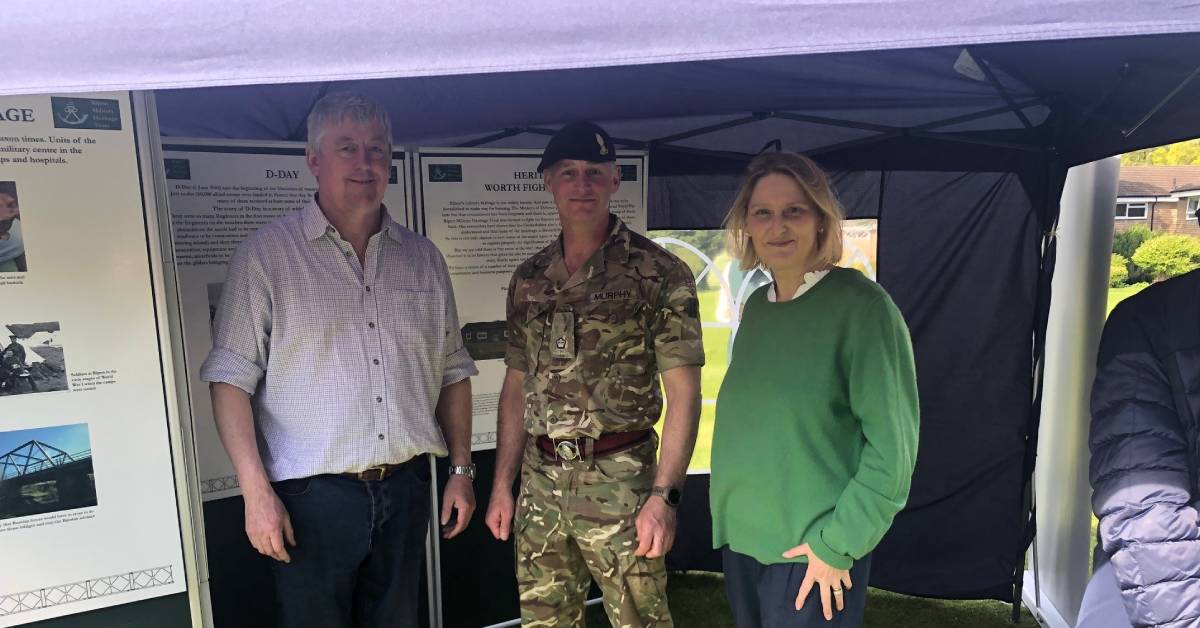Planning update
Last week, the government agencies Homes England and the Defence Infrastructure Organisation provided an update on the Clotherholme proposals in a planning report published on North Yorkshire Council’s website.
The report pledged to “work with the Ripon Military Heritage Trust on a heritage strategy which will balance the urgent need for new homes for local people with a strategy for preserving and recording the unique history and heritage of the barracks”.
The trust’s continuing concerns
But the trust, which has launched a website as part of a campaign to preserve key aspects of the site, believes the agencies have shown little desire to co-operate since Harrogate Borough Council granted planning permission in February last year and their pledges remain vague and opaque.
Trust chairman Guy Wilson said:
“We are hugely disappointed that after 15 months of engagement with Homes England, the current outline planning application lacks any provision for the preservation of even a single example of the rare and unique huts at Deverell Barracks.
“Neither has any land been allocated to allow for the relocation and re-use of these heritage assets. Both were specific requests that the Harrogate Borough Council planning committee called for in February 2023.
“It has sadly become apparent that none of the parties to this development has any real interest in preserving the heritage of the site and none has made any attempt to work constructively with us. All they are interested in is appearing to do enough to get their present plans passed without alteration, in which case the result will be that significant heritage assets will be lost and this we very much regret.”
The planning update said the housing scheme will preserve the main military roads and names as well as provide information signs
Trustee Michael Furse told the Stray Ferret:
“The city has a rich and deep military history and has enjoyed a long and close relationship with the Royal Engineers.
“We and many Ripon residents strongly believe that the important heritage assets at the barracks site are worth fighting for.”
Main image: Field-Marshal Montgomery recognised the important role that Ripon’s Royal Engineers played in the installation of Bailey Bridges, such as this one in Italy. Picture Wikipedia
Read more:
- The countdown is on for Ripon’s D-Day anniversary event
- Rallying call from Ripon Military Heritage Trust
Ripon military heritage campaigners to hold public launch
An organisation fighting to save forgotten but nationally important military heritage will hold its public launch in Ripon on Saturday.
Members of Ripon Military Heritage Trust (RMHT) will be on hand at Market Square from 10am to tell people about the campaign to protect and preserve structures and buildings currently threatened by demolition as part of a redevelopment of MoD property by the government agency Homes England.
The redevelopment area at Clotherholme is currently occupied by Claro and Deverell Barracks and the Laver Banks Training Ground.
Trust chairman Guy Wilson, former Master of the Royal Armouries (RA) who played a leading role the creation of the RA museum in Leeds, said:
“Ripon has a long and rich military heritage but its key role in helping secure the liberation of Europe in the Second World War and then maintain it has been largely forgotten.
“The redevelopment site at Clotherholme contains a number of unique and very rare military buildings and structures, worth preserving on their own account, but even more so when what was happening in and around them is understood.”
The relocation of the Royal School of Military Engineering to Ripon in 1940 meant the city played a huge part in training combat engineers.
It was here that the famous Bailey bridge, in its many varieties, was tested and perfected before seeing use in theatres of war across the world. So important was bridge building and the other engineering activities in Ripon that the US Army formed its own ‘American section’ to train its key engineers.
Early in the war British army bomb disposal training was centralised on the site and in the aftermath of Japan’s attack on Pearl Harbour, a secret delegation of US Army personnel, led by Major Thomas Kane, came to the city to train.
On completing the course they were presented with Royal Engineer ‘Bomb Disposal’ patches and given the unique honour of being able to wear them on their US Army uniforms.
Kane returned to the Unites States where, with British help, he set up his own version of the Ripon School. He is regarded as the father of US Army Bomb Disposal.
Saving some of the remaining structures at Clotherholme that tell this story and its continuation into the Cold War is the RMHT’s first important task. But it has a wider remit and is dedicated to researching and preserving Ripon’s long and varied military heritage.
The trust aims to preserve a number of the surviving structures on a site at Laver Banks and develop a military heritage centre alongside countryside trails which will interpret the city’s unique military heritage.
Pictured above are members of the trust on the Heavy Girder Bridge at Laver Banks. From the left: Lt Col Bob Lisle (ret’d), Jane Furse, Stuart Martin MBE, Guy Wilson and Michael Furse. Picture: Ripon Military Heritage Trust.
Read more:
Priceless military heritage to be protected at Ripon development site
Fears that priceless elements of Ripon’s rich military heritage could be flattened to make way for the 1,300-home Clotherholme scheme have been allayed.
Jane Furse, a trustee of the Ripon Military Heritage Trust, which has plans to create heritage trails on the development site, told the Stray Ferret:
“We were concerned that some extremely rare huts on the Deverell Barracks part of the site, and other historically important structures, would be demolished, but I’m relieved to say that this will not be the case.
“These huts are among the few surviving of their kind in the UK and help to tell the story of the vital national and international role that Ripon’s Royal Engineers played in just about every aspect of World War II and subsequent conflicts.
“This included training British and allied troops in the erection and use of Bailey Bridges in theatres of war such as Sicily and France and bomb disposal, that saved the lives of civilians and military personnel around the world.”
Minutes of Harrogate Borough Council’s February 23 planning meeting at which Homes England was seeking outline approval to progress development of the huge Clotherholme scheme, confirm that the huts and other structures will have protection.
Under the provisions of a Section 106 agreement the developer is required to put in place a strategy to ‘secure military heritage within the site.’

Jane Furse of Ripon Military Heritage Trust pictured at the barracks site
The planning meeting minutes also say:
“Prior to the commencement of works to each phase of development, a record (including photographs, drawings and summary of historic analysis) shall be made of a representative selection of buildings with military heritage on site and shall be submitted to and approved in writing by the local planning authority. Copies of this record shall be placed on the North Yorkshire Historic Environment Record.”
Ms Furse, an architectural historian and former inspector of historic buildings with English Heritage (now Historic England) pointed out:
“Inclusion within the S 106 agreement means that the significance of military heritage assets at the site has been formally recognised and that is very welcome news.
“It means that we can go forward, in liaison with Homes England and other parties, to progress plans for military heritage trails at Clotherholme that alongside other heritage attractions, will add to the city’s development as a tourist destination.”
Bomb disposal and the American connection
The wooden huts at Deverell Barracks are of heritage importance, because they are identical to ones that were located at the nearby Harper Barracks which became the home of the Royal Engineers’ School of Bomb Disposal in 1941.
Setting up of the national school in Ripon, soon saw Royal Engineers based in the city providing vital training and passing on know-how to the Americans, in the wake of Japan’s attack on Pearl Harbour, the USA naval base.
Ms Furse said:
“The Royal Engineers sought out examples of every known enemy bomb and developed countermeasures to defuse them. The School developed a rigorous training programme in bomb identification and disposal methodology.
“The Americans, although aware of the threat of unexploded bombs, had no proper procedures for safe disposal and the aftermath of the bombing of Pearl Harbour on December 7 1941, meant that for the first time, they were faced with unexploded bombs scattered throughout their bases and the harbour.
“On December 9, the British Military Attache’s office in Washington received a request for a joint personnel exchange – an early example of the ‘special relationship’ between ourselves and the USA.
“A group of eight hand-picked American soldiers headed by Major Thomas J Kane, travelled to Ripon to train with the Engineers, arriving on February 1 1942.
“After six weeks of attending lectures and demonstrations, all of the U.S. Army ordnancemen passed the course and were made honorary Royal Engineers – they were even given official RE patches and allowed to wear them on the sleeves of their American uniforms.”
The expertise gained from the Royal Engineers in Ripon subsequently saw Major Kane set up the USA’s first Bomb Disposal School in Maryland.
Read more:
- Made in Chelsea star in Ripon marathon fundraiser
- Free entry to heritage attractions in the Ripon area


